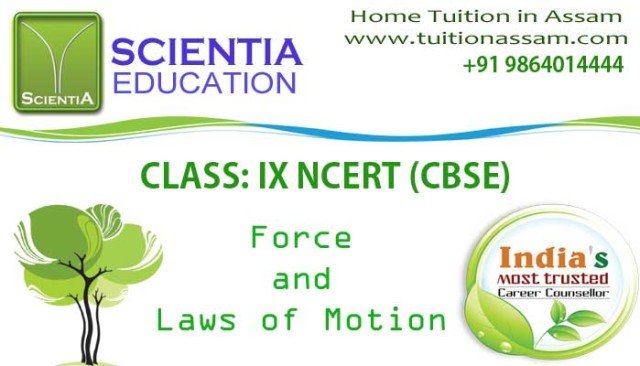
CLASS: IX NCERT (CBSE)
Force and Laws of Motion
SUMMARY
If an object does not change its position with respect to time and the surroundings, it is said to be at rest, else it is said to be in motion.
Force is that which changes or tries to change the state of rest or of motion of an object by a push or pull. The magnitude of force on an object is given by the product of the mass of the object (m) and its acceleration (a). Mathematically it is expressed by the equation, F = ma. CGS unit of force is dyne and the SI unit is newton (N).
The line along which a force acts on an object is called the line of action of the force.
The point where the force acts on an object is called the point of application of the force.
When a number of forces act simultaneously on an object then their equivalent is the net force on an object. If the net force is zero the forces are said to be balanced which results in zero acceleration, else the forces are said to be unbalanced which results in acceleration of the object.
The force that opposes the relative motion between the surfaces of two objects in contact and acts along the surfaces in contact is called the force of friction or simply friction.
An object by its own does not change its state of rest or uniform motion. This inability of any object to change its state is called inertia. Newton’s first law of motion gives the concept of inertia and force. According to the law, any object in the universe remains in its state of rest or uniform motion. Inertia is of three types, namely Inertia of rest, Inertia of motion and Inertia of direction.
Mass of an object is an intrinsic property of matter. Mass is a measure of inertia of an object. If an object does not change its position with respect to time and the surroundings, it is said to be at rest and else it is said to be in motion.
The rate of change in position of an object is velocity.
If an object covers equal displacements in equal intervals of time, the motion is called uniform motion, else it is non-uniform motion.
When a cricketer catches a ball he moves his hand back while catching the ball. He does this to reduce the impact, which is the force of the ball on his hand. An object in motion has momentum.
Momentum is defined as the product of mass and velocity of an object. The momentum at the start of the time interval is the initial momentum and at the end of the time interval is the final momentum. The rate of change of momentum of an object is proportional to the applied force.
Newton’s second law quantifies the force on an object. The magnitude of force is given by the equation, F = ma, where ‘m’ is the mass of the object and ‘a’ is its acceleration. The CGS unit of force is dyne and the SI unit is newton (N).
A large amount of force acting on an object for a short interval of time is called impulse or impulsive force. Numerically impulse is the product of force and time. Impulse of an object is equal to the change in momentum of the object.
For every action, there is an equal and opposite reaction is Newton’s third law of motion. This tells us that all forces in nature acts in pairs. These actions and reactions help in understanding the motion of bodies on which forces act. The law also helps in resolving issues in several applications of forces, namely when two bodies collide.
The momentum of the bodies before collision and after collision can be worked out using the third law. If we consider bodies moving along a straight path, the momentum they possess is called linear momentum. If two spheres in a linear motion collide, their momentum before and after the collision can be related using Newton’s third law of motion.
The derivation from the third law of motion, using the mathematical expression of force, which is derived from Newton’s second law of motion, enunciates that in the absence of external forces, if two bodies collide, the total momentum of the bodies before the collision and after the collision remains the same. This is the law of conservation of linear momentum.
After collision if the two bodies stick together, their common speed or velocity can be calculated by using the law of conservation of linear momentum. There are several applications of Newton’s third law of motion; the launching of satellites is one among them.














